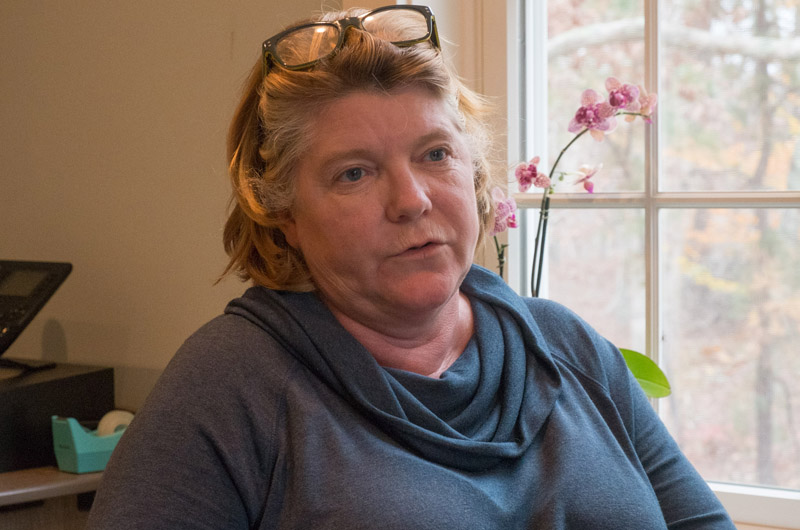The Island Wide Youth Collaborative has officially moved into their new home, a freshly shingled building nestled in the back of the Martha’s Vineyard Community Services compound across from the regional high school. The concept of the collaborative has been in the works for the last two and a half years, and up and running for six months. They moved into their permanent home last week, happy to be no longer operating out of a basement conference room.
On Saturday, Nov. 14, from 11 a.m. to 3 p.m. the group is hosting an open house to formally introduce the new building to the community.
The collaborative essentially serves as a family resource center, and its partners include the Youth Task Force, YMCA of Martha’s Vineyard, Martha’s Vineyard schools, the Martha’s Vineyard Hospital and Martha’s Vineyard Community Services, which also serves as the program’s home. It intends to help families with children from newborn to 26 years old.
Community Services executive director Julie Fay said that when forming the collaborative they did a needs assessment and identified huge gaps in services on the Island.
“We’re all dealing with the same families,” she said of the separate partners. “But as we interact there is little continuity, we pass kids off like a baton in a relay.”
Children may interact each day with many adults in the community but traditionally there has not been much overlap between the agencies.
“We all need to be on the same page, making sure [the kids] have the services they need,” program director Susan Mercier explained.
The collaborative can help with something as simple as finding a primary care physician and ensuring that services are not duplicated, to facilitating training opportunities for professionals on the Island so they are equipped to deal with specific issues like eating disorders.
The case managers at the collaborative, Ryan Schwab-Doyon and Melanie Devaney, have already fostered a close relationship with the schools. Every other week they visit schools and have conversations about which families may benefit from support.
Since it began operations, the collaborative has worked with nearly 80 families. Some of the services serve particular communities on the Island, like the headset translation service that allows non-English speaking Brazilian parents to participate in the groups they offer. They also hosted a special late summer transition-to-kindergarten workshop in Portuguese for the Brazilian community.
On the Island, there can be gaps in services that are unique to the isolated setting and small community. Specific examples include the lack of teen specific recovery programs, something the collaborative is working to fill, and that the Island cannot support a crisis stabilization unit because the regulations require 26 beds to be at 95 per cent occupancy and the Island will never have those numbers, explained Ms. Fay. Another gap the collaborative identified is a group for eating disorders, something that has already been remedied. Before, those struggling with eating disorders could see a therapist with or without expertise or see a nutritionist. But those were isolated situations, with no sense of a shared experience.

For parents, Mrs. Mercier said the collaborative will provide a place for them to talk.
“Our goal is to create opportunities for parents to come together other than the field while our kids play games,” she said.
The collaborative will soon begin hosting parent workshops every month. In December, Lynn Lyons, an expert on child anxiety, will do two evenings of free workshops for parents in the community. From these workshops, the collaborative hopes to create opportunities for parents to talk about what is going on with their children.
Having a building to call their own really grounds and centralizes the efforts of the collaborative. They are particularly proud of the kitchen.
“Typically when you think of a support group, it’s sitting around and talking,” said Ms. Fay. “Take the same group, put them around a cook top and a nutrition lesson, and they can gel around food prep or an activity like that.”
Even if a person is unsure of the resource they need, but think they may need assistance, the collaborative is there to help.
“Not everyone is going to come in and know what they need,” said Nell Coogan, director of operations and community relations at Community Services. At the front of the building there is computer station set up so visitors can check the online resource guide. They can also speak with Jenn Chang, family support worker and the face of the collaborative.
The front room is decorated with several bright chairs, including a goofy giraffe chair. The walls are painted a light yellow and a calming blue, chosen specifically for the mood they create. The collaborative wanted the building to feel both accessible and private. While the walls are thick and every office can close its door, there are always snacks available from a small window into the kitchen, and the family room has comfortable blue couches and opens onto a porch in nice weather.
Funded by grants from The Tower Foundation and MV Youth, the building cost just under half a million dollars and took a little over six months to complete. It was furnished by a fundraiser held by Jan Buhrman and Vicki Divoll.
“It’s [the community’s] building,” said Mrs. Mercier. “A place where they can come and meet one on one, but also a place to learn and meet other parents.”





Comments
Comment policy »